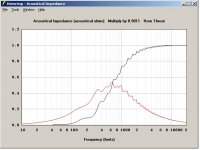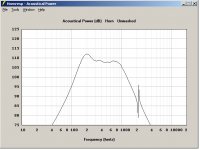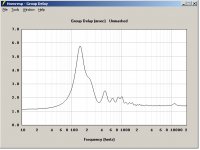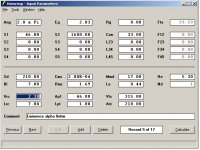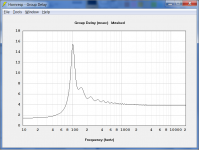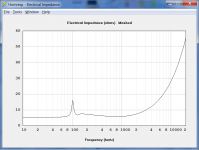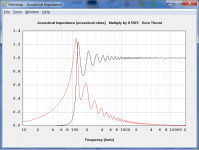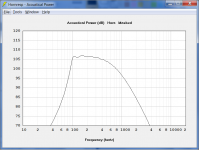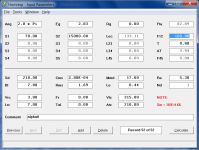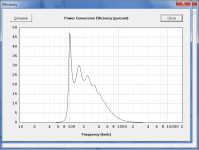Also me, I am curious if Eminence Beta15a is OK for a PPSL sub. And what freq. can cover. I know it is a little OT but maybe Djk can provide a quick answer 🙂
(I will read the thread "A Thread for those interested in PPSL enclosures ". ) oh boy, so much to do/read 🙂
(I will read the thread "A Thread for those interested in PPSL enclosures ". ) oh boy, so much to do/read 🙂
400hz is about the limit.
The builder (of the above photo) had to re-do his to make it get up to 400hz.
Les Hudson (round HF photo) said they worked well to 400hz.
I have a way to get higher, but the construction is bifurcated and requires one smooth 90° bend.
The builder (of the above photo) had to re-do his to make it get up to 400hz.
Les Hudson (round HF photo) said they worked well to 400hz.
I have a way to get higher, but the construction is bifurcated and requires one smooth 90° bend.
Regarding Mid bass horns.
After some simulations, i have a few questions:
1) should i simulate to have a high efficiency power conversion in detriment of acoustical power? I mean, some simulations look good but efficiency is below 10%. Other sims, with +-4dB peaks and valleys have a 20-40% efficiency.
2)The impulse response is better to have the negative after-shot as long as possible or as short as possible? Or more important is that the impulse response is as short as possible in time axis, and after the negative shot, there are no more traces of impulse visible?
3) group delay between 100 and 200hz is always 4 to 10ms. Should i be worried about this?
After some simulations, i have a few questions:
1) should i simulate to have a high efficiency power conversion in detriment of acoustical power? I mean, some simulations look good but efficiency is below 10%. Other sims, with +-4dB peaks and valleys have a 20-40% efficiency.
2)The impulse response is better to have the negative after-shot as long as possible or as short as possible? Or more important is that the impulse response is as short as possible in time axis, and after the negative shot, there are no more traces of impulse visible?
3) group delay between 100 and 200hz is always 4 to 10ms. Should i be worried about this?
Last edited:
" if Eminence Beta15a is OK for a PPSL sub"
Only if huge, or an open 'H' baffle (after Linkwitz).
I am going to make a SLOB with four 12's in PPSL.
Only if huge, or an open 'H' baffle (after Linkwitz).
I am going to make a SLOB with four 12's in PPSL.
4x12 ppsl SLOB
"I am going to make a SLOB with four 12's in PPSL. "
Me too, but I started that project over 1 year ago, and completely lost interest.
So, Dennis, when you get yours done, please share the results. Thanks.
" if Eminence Beta15a is OK for a PPSL sub"
Only if huge, or an open 'H' baffle (after Linkwitz).
I am going to make a SLOB with four 12's in PPSL.
"I am going to make a SLOB with four 12's in PPSL. "
Me too, but I started that project over 1 year ago, and completely lost interest.
So, Dennis, when you get yours done, please share the results. Thanks.
Since no replies I'll take a guess for you. The horn is better loaded before the black line meets the red, and hangs on a bit lower, say until it gets to around 0.2. When choosing the low point you should look at group delay. Driver electrical impedance also gives a clue.
Thanks Allen!
In all simulations usually there is a spike in group delay until it settles at 300Hz. So better to cross high pass at 300Hz i guess.
This is only a test horn, will be my first horn, but i want to get the most out of it without sacrificing the sound.
In all simulations usually there is a spike in group delay until it settles at 300Hz. So better to cross high pass at 300Hz i guess.
This is only a test horn, will be my first horn, but i want to get the most out of it without sacrificing the sound.
Attachments
Some would say you should begin crossing when the group delay begins to deviate. This would be around 1kHz here but if you ignore the wiggles and focus on the main peak, I'd want to cross an octave higher, maybe 500Hz.
I don't think this would be a good horn in practice. Can you post your input page, maybe there is something better that we could come up with.
I don't think this would be a good horn in practice. Can you post your input page, maybe there is something better that we could come up with.
Ok. Don't know how you want to use this one. A conical horn doesn't load well below 1000Hz. If you use it into bass it can still waveguide but will be huge and hardly worth it. I used a LeCleach (0.8) profile, which is a hyperbolic exponential variant, just because it's something I use in this band.
As you say this is probably not the first choice of driver for a horn, but no problem. As you optimise you'll probably find the size limits you and you'll have to put up with some response compromises.
I just tossed out this example centred around 100Hz. With a LeCleach horn this usually means crossing at 200Hz, but you might push that down a little as we're a bit less sensitive at lower frequencies.
Notice I've adjusted the rear volume to take the resonance shown in the electrical impedance to 100Hz. Also the acoustical impedance shows good driver loading in the passband. The group delay is more smooth in the passband, and the efficiency screen can confirm the region where the horn is effective.
As you say this is probably not the first choice of driver for a horn, but no problem. As you optimise you'll probably find the size limits you and you'll have to put up with some response compromises.
I just tossed out this example centred around 100Hz. With a LeCleach horn this usually means crossing at 200Hz, but you might push that down a little as we're a bit less sensitive at lower frequencies.
Notice I've adjusted the rear volume to take the resonance shown in the electrical impedance to 100Hz. Also the acoustical impedance shows good driver loading in the passband. The group delay is more smooth in the passband, and the efficiency screen can confirm the region where the horn is effective.
Attachments
Allen, thank you.
I was hoping to use it in ~200 - ~1k Hz region. And i choose conical because of simplicity of building. I simulated a 3-part conical horn but efficiency was in 5-20% region. Mouth size is a factor, would like to keep in the 2000cm2 region.
In my simulations group delay is lower, somewhere near 2ms. I think that has to do with axial length of the horn, which is shorter in my simulations than this LeCleach horn.
Do you think that a 5-20% efficiency would be to low to consider building the horn?
I was hoping to use it in ~200 - ~1k Hz region. And i choose conical because of simplicity of building. I simulated a 3-part conical horn but efficiency was in 5-20% region. Mouth size is a factor, would like to keep in the 2000cm2 region.
In my simulations group delay is lower, somewhere near 2ms. I think that has to do with axial length of the horn, which is shorter in my simulations than this LeCleach horn.
Do you think that a 5-20% efficiency would be to low to consider building the horn?
The natural efficiency of many drivers is lower than 1%. Yes, group delay is related to length. It doesn't matter. Horn resp measures that from the mouth. If you moved back from the short horn it would be the same. It is the variations that count. It will be correct when the drivers align in their distance from the listening position.
Your mouth size will be limiting. My tweeter has a mouth 5000cm^2 and I cross around 1kHz. Ok, it is as large as necessary and you can compromise. Maybe you can place it on the floor or baffle it, or at least round the mouth over.
Your mouth size will be limiting. My tweeter has a mouth 5000cm^2 and I cross around 1kHz. Ok, it is as large as necessary and you can compromise. Maybe you can place it on the floor or baffle it, or at least round the mouth over.
Do you have a link/info for that tweeter horn? I bought two Selenium 220ti drivers that i want to horn-load.
You can convert another type of horn to a 3 part conical when you build it, just pay a little more attention to the throat.
Try the input screen I posted and change the mouth to 2000. It will still work. You'll have more ripple in the plots. Then look at the schematic and you'll see it is not too far from conical.
EDIT: when you do this it is easier to model it as the other type rather than conical parts, until you find what you want then model it as conical.
Try the input screen I posted and change the mouth to 2000. It will still work. You'll have more ripple in the plots. Then look at the schematic and you'll see it is not too far from conical.
EDIT: when you do this it is easier to model it as the other type rather than conical parts, until you find what you want then model it as conical.
Last edited:
It is hand made, unfortunately. Here is a link.Do you have a link/info for that tweeter horn? I bought two Selenium 220ti drivers that i want to horn-load.
That is big! 🙂
How does it sound? Compared with the same driver on a smaller horn. Does this big horn + driver makes a difference? That big mouth area can reproduce cymbals sound better?
I play bass guitar and i am disappointed by how percussion sounds on home speakers.
How does it sound? Compared with the same driver on a smaller horn. Does this big horn + driver makes a difference? That big mouth area can reproduce cymbals sound better?
I play bass guitar and i am disappointed by how percussion sounds on home speakers.
There is much percussion information around the typical baffle transition. This is a tricky region to deal with but it can be done. The lateral radiation can be exposed to early reflections and when you think of it, that's the main way this sound gets to you, and what does should be subtracted from the baffle step compensation... which may mean parametric style compensation to get it right.i am disappointed by how percussion sounds on home speakers.
Then they will still be afflicted by delay, and you won't fix the nulls.
I think what makes a mid or midbass horn attractive includes directing this sound. At least down to somewhere around 400Hz. A large woofer can do this to some degree. Taking a horn down to 200-100Hz gets large but directivity becomes less important.
I use my horn down to 80Hz using a 15" JBL. You need to sit in front of it. That is why I prefer my other setup with a 15" JBL in a BR tuned to 55Hz. Now I have the freedom to move about in the room and even invite some friends!
Also rock music sounds more natural with BR. The horn is more for detailed solo performances like Nils Lofgren - Keith Don't Go. Then it is unreal and magical and very interesting to listen to.
Also rock music sounds more natural with BR. The horn is more for detailed solo performances like Nils Lofgren - Keith Don't Go. Then it is unreal and magical and very interesting to listen to.
Last edited:
Above the crossover the conical section is doing most of the work. The roundover is mostly dealing with horn resonance that involves the mouth. With most of the roundover removed I have more trouble crossing below 1kHz, and it also helps with diffraction at higher frequencies.How does it sound? Compared with the same driver on a smaller horn. Does this big horn + driver makes a difference? That big mouth area can reproduce cymbals sound better?
Cymbals? These can have a fundamental in the lower hundreds of hertz of course so the roundover is good, but the higher frequencies will not really go there. Once they travel past a point on the horn they become mostly independent so this is no different to a smaller tweeter at the throat.
The image stays steady as it crosses past the speakers. It disappears with any recording.
- Status
- Not open for further replies.
- Home
- Loudspeakers
- Multi-Way
- Midbass horn
